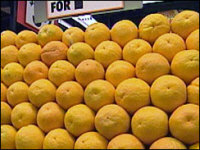



Do You Know Where Your Food Comes From?
US - In the wake of banned seafood from China and years of concern over mad cow-tainted beef from Europe, many consumers are worried about where their food is coming from. |
| It can be very hard for the consumer to tell where oranges like this come from. (CBS) |
A new Consumer Reports survey shows 9 of 10 Americans want imported foods labeled with their country of origin. In 2002, Congress passed a law that mandated that all foods be labeled with their country of origin, but five years later, that regulation has only been implemented for seafood.
The Early Show consumer correspondent Susan Koeppen went to a supermarket with a food safety expert and found that figuring out where many foods come from is virtually impossible and some food labels are even misleading.
"The government guidelines right now don't require that all products be labeled where they come from," Consumer Reports scientist Dr. Urvashi Rangan said.
Right now, only seafood is required to list its country of origin and about 80 percent of the seafood sold here is imported.
"If you ask your fish monger where that fish is from, they should be able to tell you," Rangan said.
But when it comes to other foods like fruits and vegetables, consumers are often left wondering.
Now, after years of delay, the government says all foods will be required to come with country of origin labels by the end of September. But how this new law would be implemented has yet to be determined and that doesn't sit well with many consumers, who have growing concerns about tainted food from China, and for years have worried about mad cow disease because of tainted beef from Europe. Moreover, only 1 percent of imported food sold in the U.S. is inspected.









